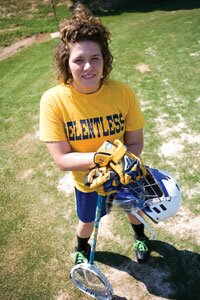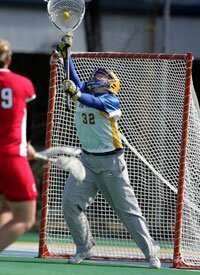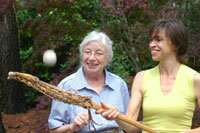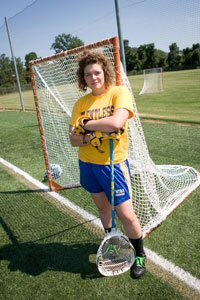COVER- 'I'm incredibly competitive': How a once obscure law gave local women their turn

Maizie Osteen
PHOTO BY WILL WALKER

Hofstra goalie Maizie Osteen makes a save.
HOTSTRA UNIVERERSITY/BRIAN BALLWEG

The two Ashlin Smiths get a smile from the younger's old lacrosse stick.
PHOTO BY GARRETT SMITH

Osteen: "It's sort of like the military– you think you might die running, but you do it together."
PHOTO BY WILL WALKER
"Player of the Week!" Hofstra University online news congratulated Maizie Osteen, a lacrosse player from Charlottesville, during this spring's season.
The gushing continued game after game: "Osteen made seven saves." "Osteen had a spectacular 4.15 goals against average." "Led by Osteen's strong play in net, Hofstra held William & Mary to just 2-10 shooting."
Later this month, after graduation caps this standout collegiate athletic career, the Charlottesville High School graduate heads across the ocean to join the Welsh national lacrosse team. A year from now, she will play in the World Cup in Prague.
As Osteen and many other talented young women make history for their respective college teams, the benefits of sports opportunities for women are obvious— now. But before and during the 1960s, most high schools and colleges had no varsity sports for women, and many simply didn't mind. Charlottesville's Lane High School had no girls' varsity sports, certainly not lacrosse.
"I really enjoyed sports and looked forward to P.E. class," says 1960s-era high-schooler and former Charlottesvillian Sandy Getlein, "but there were no teams for girls."
Betsy Cochran, an athletic California high school student in the '60s, now a psychotherapist in town, says, "That was so far out of my realm of thinking I didn't even consider it."
Millie Fife, today an administrator with Sojourners Christian Church, remembers, "There was an aura that any girl who did sports was gay."
When coach Brenda Langdon started track and field for girls in Dinwiddie County, her athletic director was humiliated. "We're going to be an embarrassment all over Virginia. Whoever heard of girls running track?" he allegedly said.
Even in the supposedly progressive atmosphere of the local newspaper office, there was resistance to covering the 1972 enactment of Title IX of the Education Amendments, which guaranteed educational equity for women. Mariflo Stephens was then a reporter at The Daily Progress.
"Doris VanDeCastle came to talk to the editor about the new law," Stephens remembers. "She was 5'11", wore pants, and had a booming voice. She went to the sports editor and tried to get him to write an article about it. He put her off on a columnist, who went blank on her, too. She argued with the news editor about the importance of the new law. He sat there scratching his head before sending her over to me.
"I had never heard of Title IX," says Stephens, "but I listened as this commanding woman talked about the changes that were coming. She said schools were going to have to put money into women's sports or lose their federal funding. Coaches would be hired, and new teams started."
VanDeCastle went on to spearhead the push for women's sports in Albemarle County schools.
Title IX has not been uncontroversial: some high school sports fans claim it has siphoned money from men's sports like wrestling, cross country, and swimming, making it harder for men to get scholarships in those sports or even to participate at the college level. [See sidebar "Cutting Men's Sports"–editor.]
Title IX was not just about sports, however. It required that educational opportunities of all kinds be equal for men and women. Athletics is one of 10 major areas the law addresses, including access to higher education, education for pregnant students, and sexual harassment.
The sponsor of the groundbreaking law, Congresswoman Patsy Mink of Hawaii, had grown up wanting to be a doctor. When she graduated from the University of Hawaii in 1948, she applied to 20 medical schools, and none accepted her.
Finally, Mink decided she would go to law school, hoping discrimination could be attacked through the courts. She was accepted by University of Chicago Law School, which had had the unusual policy of enrolling women since it opened in 1902.
Mink started her political career by getting elected president of the student body at her high school in Maui where in 1942, just after Pearl Harbor, her campaign had to overcome the fact that she was Japanese. In addition, it was unheard of for a girl to aspire to student office. Mink devised a strategy of impressing the various cliques, including the popular football team. Her strategy worked, and she was elected by a narrow margin. After graduating in 1944 as class valedictorian, she became the first female attorney in Hawaii and was elected a Representative of the Territory of Hawaii before it was a state.
In 1965, Mink was elected the first female minority member of Congress. She introduced the first Early Childhood Education Act and authored the Women's Educational Equity Act (1974). Most importantly, perhaps, along with Congresswoman Edith Greene of Oregon, she co-wrote Title IX.
***
Title IX brought Ashlin Smith, her husband, and their daughter, also named Ashlin, to a school board meeting at Charlottesville High School in 1981.
The younger Ashlin was a leading athlete, a member of the St. Anne's varsity lacrosse team. In tenth grade she transferred to CHS where she started a lacrosse club. But as a club sport with no coach and no uniforms, the female lacrosse players had to borrow uniforms from the field hockey club. Ashlin was infuriated by the disparity between her team and the varsity boy's lacrosse team.
"She was a fighter, and she was mad," her mother says.
Father Lloyd Smith went to talk to the school principal, Ron Hutchinson, who allegedly insisted there was no money in the budget for a girls' lacrosse team. After informing Hutchinson that the school was in violation of the law, Smith and his family headed directly to the School Board.
Former Mayor Nancy O'Brien has a vivid memory of the senior Ashlin's appearance that day.
"She was such a lady, gently insisting," O'Brien recalls. "She requested girls' teams in lacrosse and field hockey. She wanted them available to her daughter. Shoes and suits weren't necessary, she said— but probably the skirts were. She seemed to remove all the major obstructions, and you just did what she wanted you to do."
Lloyd Smith remembers telling the School Board, "In 1971 UVA tried to put off a woman applicant, and the federal judge said, ‘You're taking women, and you're taking them this fall.'" He also recalls that after he spoke, a staff member from CHS came up to him and said, "The girls don't want this."
Obviously, that person didn't know that 40 girls had signed up for the lacrosse club.
Faced with the power of the new law, the School Board yielded to public pressure and voted to make girls lacrosse a varsity sport and hired current Fairview swim coach J. J. Bean as the first coach.
"Coach Bean would say, ‘Come on down and let's talk about this team,'" recalls the younger Ashlin. "He would have everybody's name on index cards, and he'd be swapping them from one position to another. ‘What do you think about this person as attackman?'"
"Lacrosse was very important to Ashlin," says the elder Ashlin. "She loved it. She would never have been happy if she couldn't do it." During Ashlin's senior year, she was chosen Most Valuable Player.
"I got a job a few months ago," Ashlin (now Ashlin Caravana) says, "and the employer looked at my resume and said, ‘I know you're going to be a competitor.' That was because I was an athlete. There's an expectation of competing and being a team member."
***
Twenty-seven years after that school board meeting, lacrosse star Maizie Osteen is crossing the Atlantic to play in the lacrosse World Cup. After starting at CHS in 1999, she found herself on a weak team, losing games 0-28 and 2-30. But by her sophomore year, the team won as many games as it lost, finishing 6-6. And in her senior year, CHS won at the highest state level.
CHS had two great coaches when Osteen played: Peggy Boutilier, who was named NCAA Woman of the Year while at UVA, and Rebecca Tweel, who played lacrosse at James Madison University.
"They helped me get to collegiate level," Osteen says. "Recruiters didn't come into the south too much. The coaches talked to recruiters for me."
Osteen decided to attend New York's Hofstra University, with a Division 1 lacrosse program in the Colonial Athletic Association, the CAA, which includes many Virginia schools including William & Mary, James Madison, and Old Dominion.
"Sports gave me confidence," Osteen says. "Of course, as an only child, my parents gave me a lot of support, but the team gives you an extended family to fight for and work with. I'm a big, tall girl. In this society, that's not so acceptable. Sports let me use my size to my advantage. I'm incredibly competitive.
"Playing lacrosse in high school made me comfortable interacting with all kinds of people. I got to know many girls who are still close friends. It's sort of like the military– you think you might die running, but you do it together.
"I was captain my senior year in lacrosse as well as in basketball and volleyball. I learned how to get everybody on the same page, how to frame issues," Osteen says. "I also learned how to deal with defeat. A coach at Hofstra said, ‘Champions are born from losses.' You figure out what you did wrong, you fix it and walk away from it."
In 2007, Hofstra won the CAA conference championship.
"I played against people from the Wales team two summers ago," she continues, "and my mother was proud of me because my grandfather was Welsh. I've been flying over to play with them once a month. I have a sponsor who pays my air fare."
***
Is Title IX still needed? Women's participation in organized sports has grown gradually over 35 years thanks to the hard work of parents, coaches, administrators, and enthusiastic girls.
Nationally, high school girls' athletic participation increased from 295,000 in 1971 to 2.8 million in 2003, according to the United States Sports Academy. College women's participation increased from 15 percent of college women in 1972 to 43 percent in 2001. The NCAA sponsors 40 women's championships, 38 men's, and three combined (rifle, skiing, and fencing) in all three of its divisions. The Virginia High School League, propelled by longtime assistant director Claudia Dodson (who retired in 2002 and died last August) has gone from just one state high school championship (gymnastics) in 1971 to 31 championships today.
The CHS yearbook of 1971 has no women's sports. By 1974, basketball, track, softball and tennis teams are pictured in the annual. The 1979 yearbook shows nine women's sports, with the addition of cross country, indoor track, swimming, field hockey, and volleyball.
"The social fabric would be so different without women's sports," says CHS athletic director Rick Lilly. "Our kids go on to be referees, agents, and athletic directors. Also, you have spectator sports and ethics in sports. Sports give kids something to think about."
Lilly says CHS offers 12 women's sports, and the coaching staff includes 22 women, nine of them head coaches.
Lawsuits were necessary to force changes in some athletic programs. In fact, it was only eight years ago that the parents of a young woman won a Title IX suit in Virginia. In 2000, the Federal District Court in Charlottesville found that the Virginia High School League violated Title IX and the 14th Amendment of the U.S. Constitution by scheduling the athletic seasons of girls and boys differently.
The League scheduled girls' volleyball, basketball, and tennis in different seasons based on school size, while all boys' sports were aligned to the same season regardless of school size. As a result, girls attending smaller schools played sports in "non-traditional" seasons, such as fall basketball and winter volleyball. Some girls in Suffolk County had been forced to drop one or even two sports because they were offered in the same season. The jury granted each of the 11 girls involved in the suit $17,000 in damages, a generous sum for a Title IX case.
"We've made enormous progress in girls' sports," said Albemarle High School's Langdon, who was the first woman athletic director at a AAA school in Virginia. "Boys and girls programs at Albemarle and Charlottesville are about equal in salaries, practice space, and the number of sports," she added, "but we need to get more female coaches coaching females.
"We need," says Langdon, "to promote attendance at women's sports so girls will participate. Sports improves their grades because they must achieve a certain level to be allowed to play. The physical activity is healthy– good for the brain, too. Scholarships give them college opportunities, and the networking gives them job opportunities."
During the 1990s, Charlottesville resident and avid tennis player Virginia Daugherty operated a printing shop and served two terms on City Council, including a stint as the mayor.
#